This bubbly overnight focaccia is salty, fluffy, and will become your go-to bread.
It took me MULTIPLE tries before I finally nailed this — and I can confidentially say that this overnight focaccia is exactly like I remember from my favorite Italian bread baskets. There’s a beautiful crumb, a golden top, and a salty olive oil flavor with every bite.

While this does take some time to make, it’s not particularly difficult — and most of the time is spent with varying rises and rests.
Also, just a note that this is an 80% hydration dough — so it’s GOING TO BE WET! If you’re not used to working with high hydrations, you may feel the need to grab more flour and throw it in the mix — please don’t do this! You need the hydration to help create that fluffy crumb and airy interior. I promise, just follow my direction and you’ll be amazed by the outcome.
Get ready to be the focaccia go-to in your group of friends!
Overnight Focaccia Ingredients
Here’s what you’ll need for this fluffy bread:
All-purpose flour: I use King Arthur AP flour for this. It has a little more protein content than other brands, but not as much as bread flour.
Extra virgin olive oil: Make sure you’re using a quality EVOO.
Active dry yeast: To help with the rise.
Honey: To feed the yeast.
Kosher salt: For flavor.
Warm water: For both the dough and the saltwater brine.
Toppings: For this I’m using EVOO, rosemary, red pepper flakes, salt, oregano, and Parmigiano-Reggiano.
How to Make Overnight Focaccia
Just a note that for the actual dough recipe, I’m using grams as my unit of measurement [this is so that we can be as precise as possible — it’s also how hydration is measured (volume of water:flour)].
I’ll switch to teaspoons when it comes to the topping and saltwater brine because those don’t need to be as precise.
Here’s how to make this focaccia:
Step 1: Mix the water, yeast, and honey
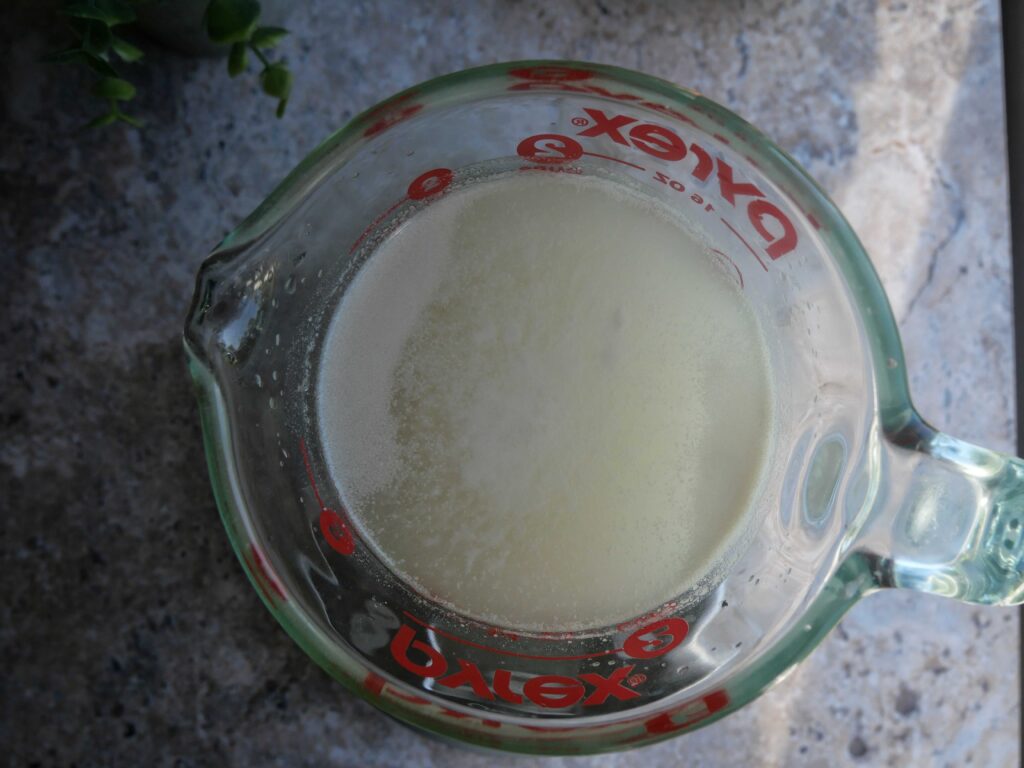
Mix 390 grams of warm water with 14 grams of honey and 2 grams of active dry yeast. Stir to combine and let sit for 5-8 minutes.
Step 2: Mix the flour and salt.
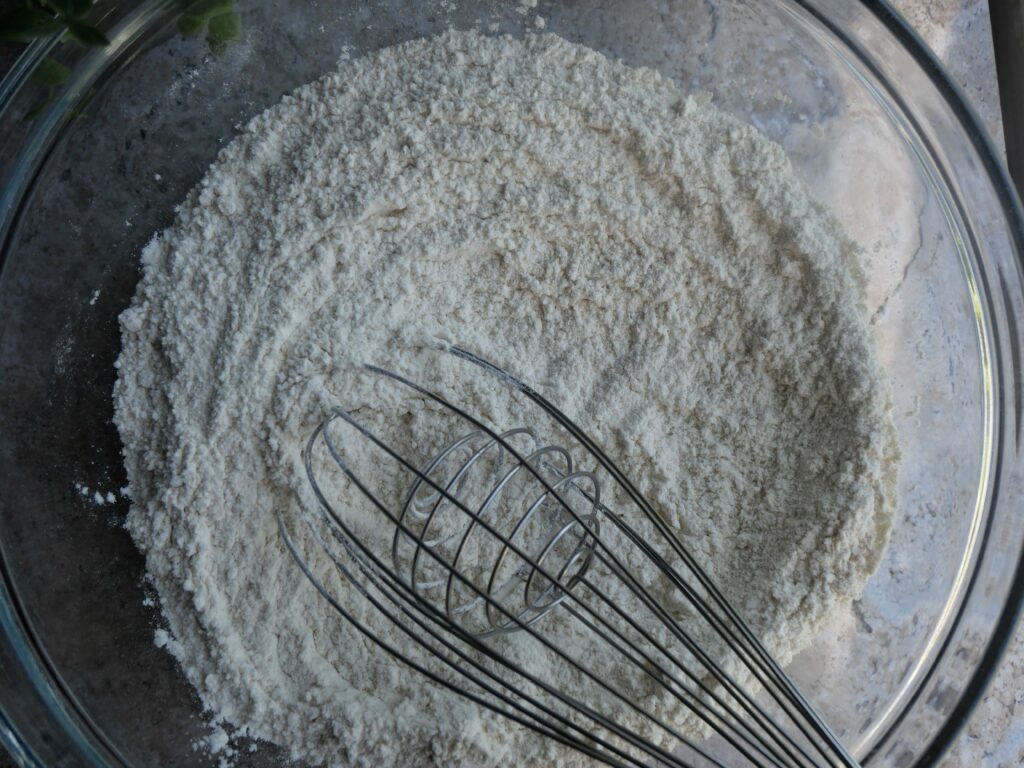
In a separate bowl, whisk together 480 grams of AP flour and 14 grams of kosher salt.
Step 3: Add the wet ingredients to the dry ingredients.
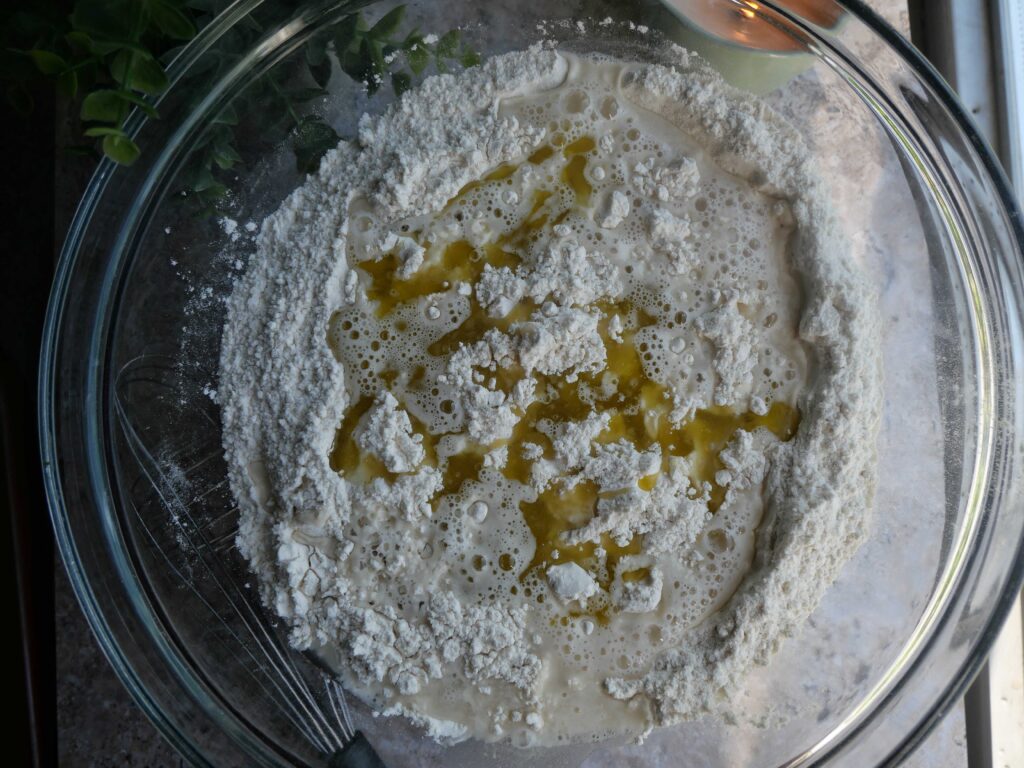
Now pour the yeast mixture into the flour mixture, and then add 40 grams of extra virgin olive oil.
Using a spatula, stir the dough until there are no dry bits left. It’s going to look like a wet, shaggy mess. This is okay!

Once your dough looks like this, cover with plastic wrap and a kitchen towel and allow to rest on the counter for 5 minutes.
Step 4: Perform your first stretch and folds.
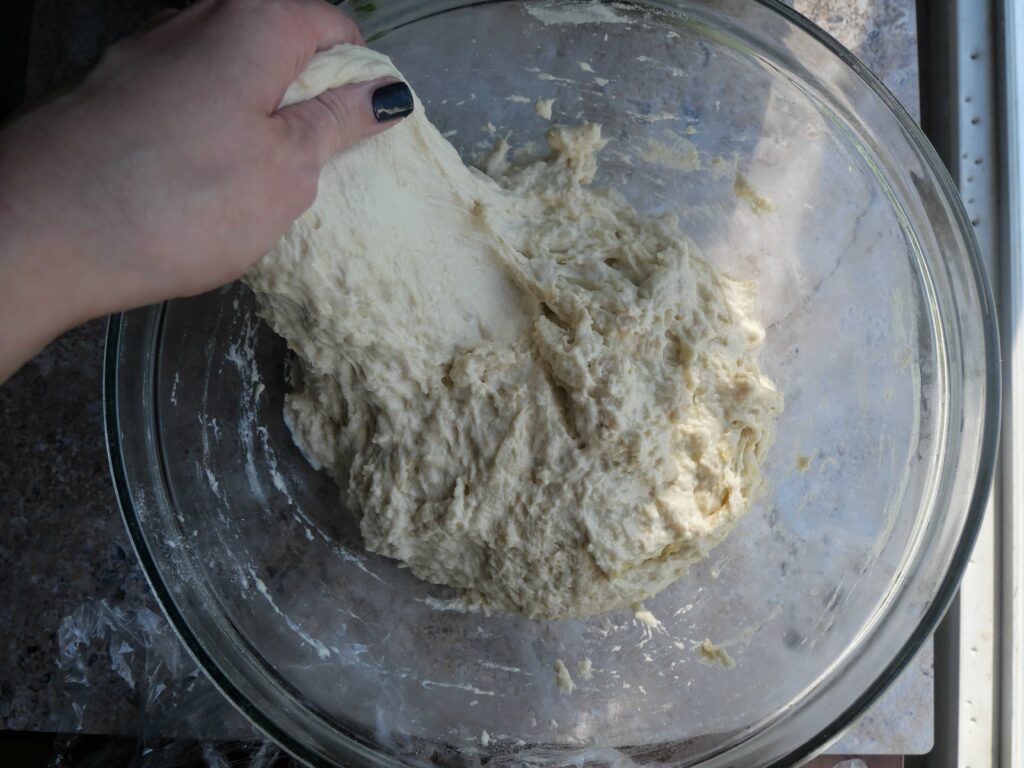
After 5 minutes, wet your hand (so that it doesn’t stick to the dough) and perform 4-5 sets of stretch and folds.
To do this, just grab a piece of the dough and stretch it out a bit, then fold it over itself like you’re wrapping a gift.
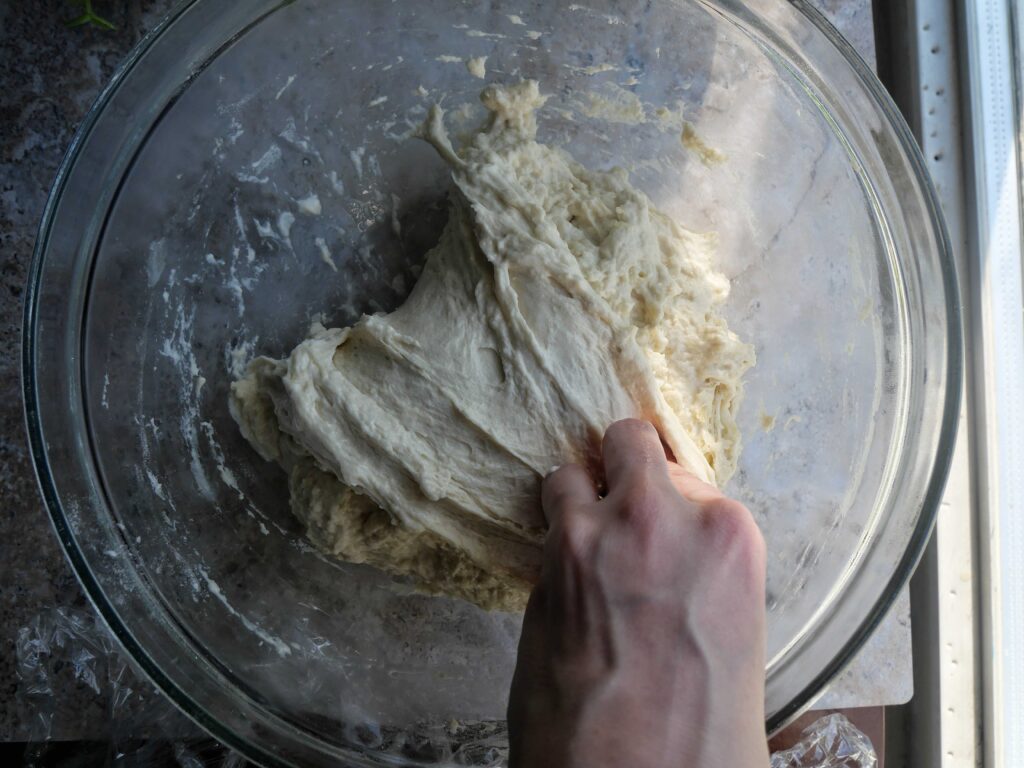
Then, rotate the bowl and do another set. Do 4-5 stretch and folds and then cover the bowl with plastic wrap and a kitchen towel and allow to rest for 15 minutes.
*Note: Make sure you’re only wetting your hand for this step. While it might feel like you want to flour your hands, we don’t want to add more flour to the dough.
Step 5: Perform another set of stretch and folds.
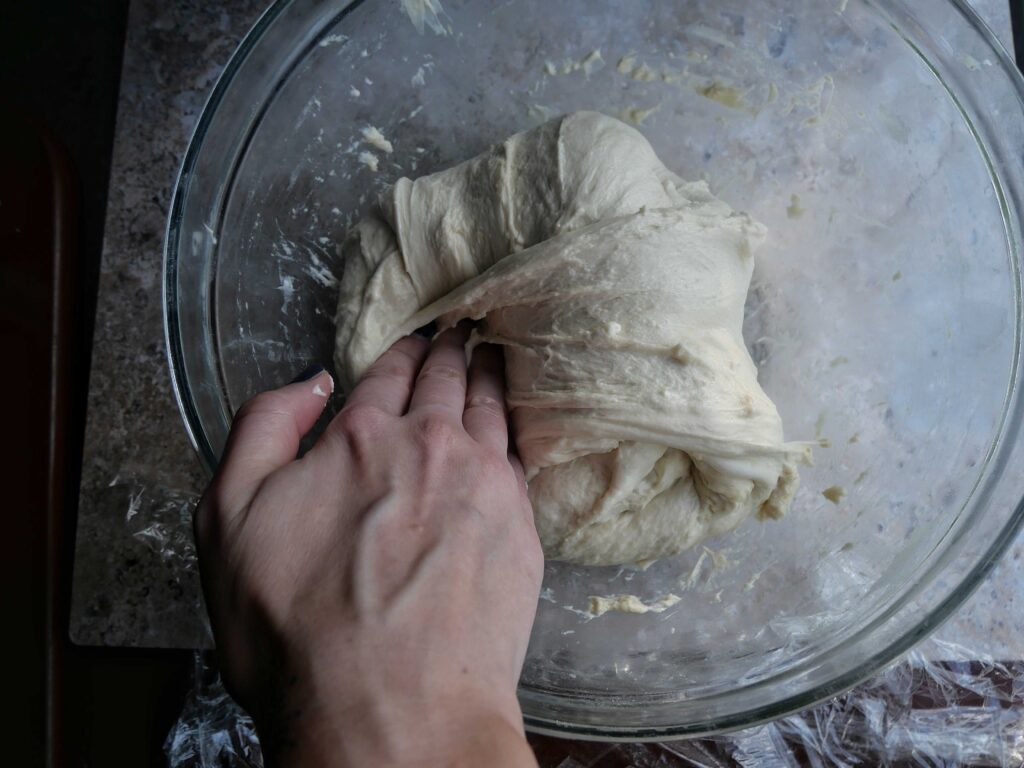
After the 15 minutes, perform another set of the stretch and folds. This time you should notice that the dough as much more structure and elasticity.
Step 6. Let the dough rest overnight.

Once you’ve fished your stretch and folds, flip the dough over so that the smoother part is on top. Drizzle with olive oil and rub it so that the dough is covered all over. Cover tightly with plastic wrap and put in the refrigerator for 12–18 hours.
Once you take the dough out the next day, it should look like this:
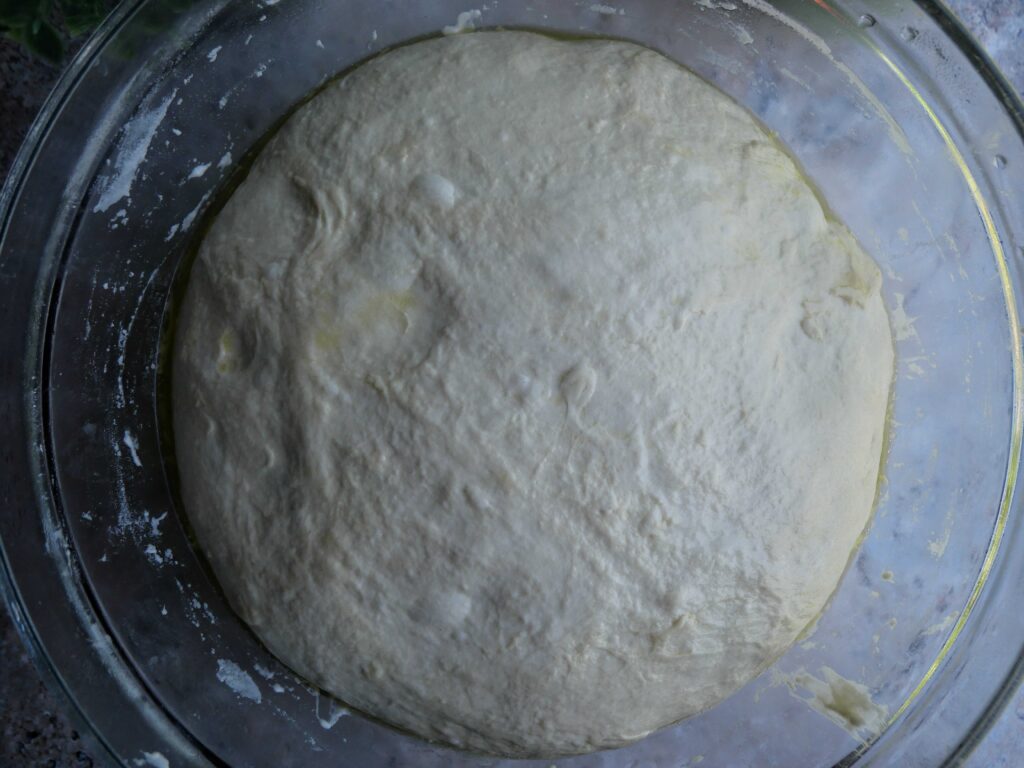
Step 7: Let dough rise in a warm place.

Happy next day! Oil a 9×13 pan and transfer the dough to the pan, making sure the smooth side is on top. you can shape it into a cute little rectangle like I did above, or just let it rest as it. Either way will work!
Cover with plastic wrap and a kitchen towel and allow to rise in a warm place (I put mine in the oven with the light on) for 2–3 hours, or until it spreads out and fills about 85–90% the pan, like this:
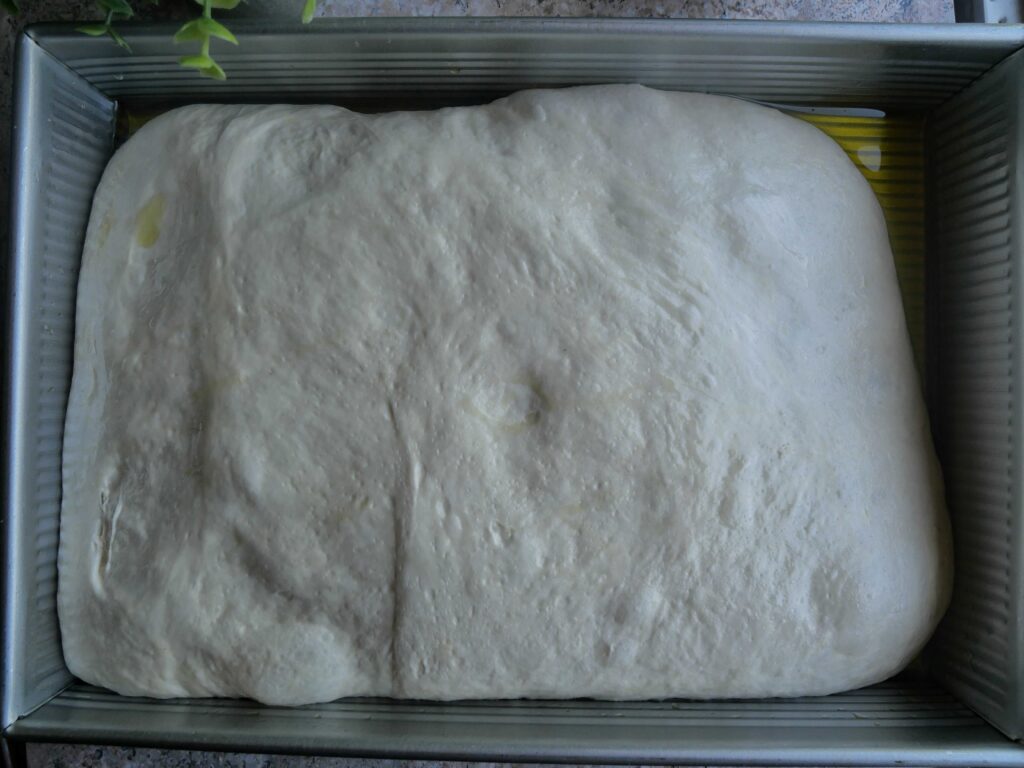
Note: You want to make sure you don’t overproof this stage! If you do, you’ll notice that the dough collapses and doesn’t have any spring to it. Since proofing time can vary depending on factors like temperature and humidity, start checking the dough at about 1.5 hours to see how much it’s growing.
Step 8: Make the saltwater brine.
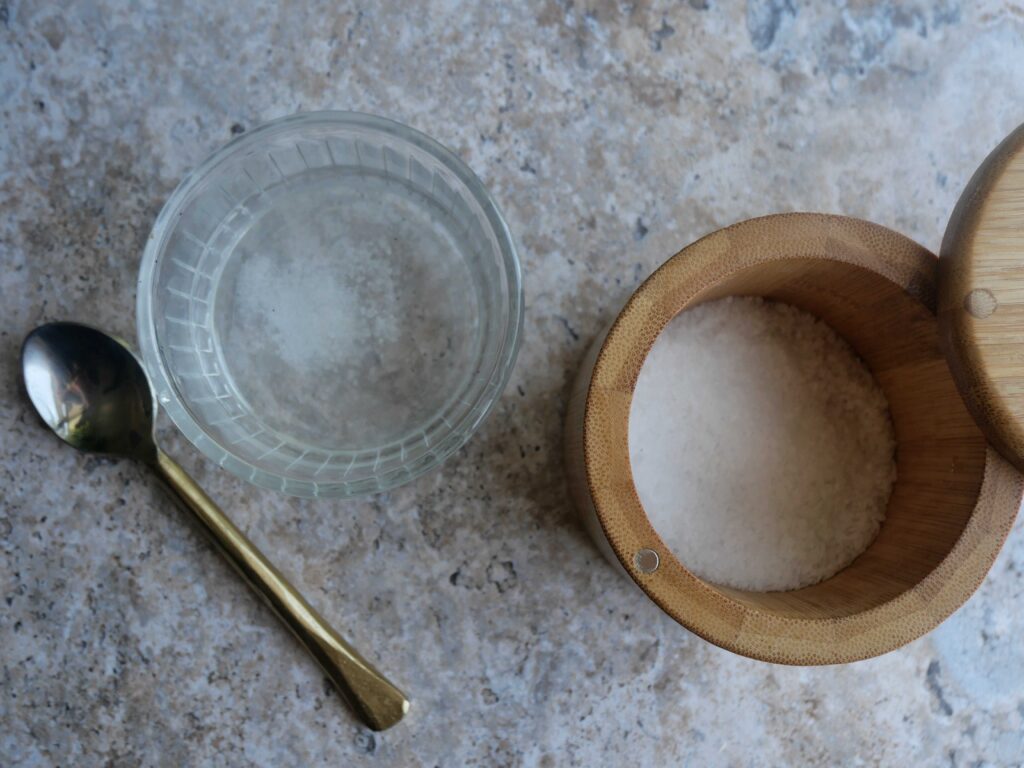
Once you’re close to the 3–4 hours being up, make the saltwater brine by combining 3 tbs warm water with 1 teaspoon kosher salt. Stir until most of the salt is dissolved.
Step 9: Dimple the dough (and let it rest)
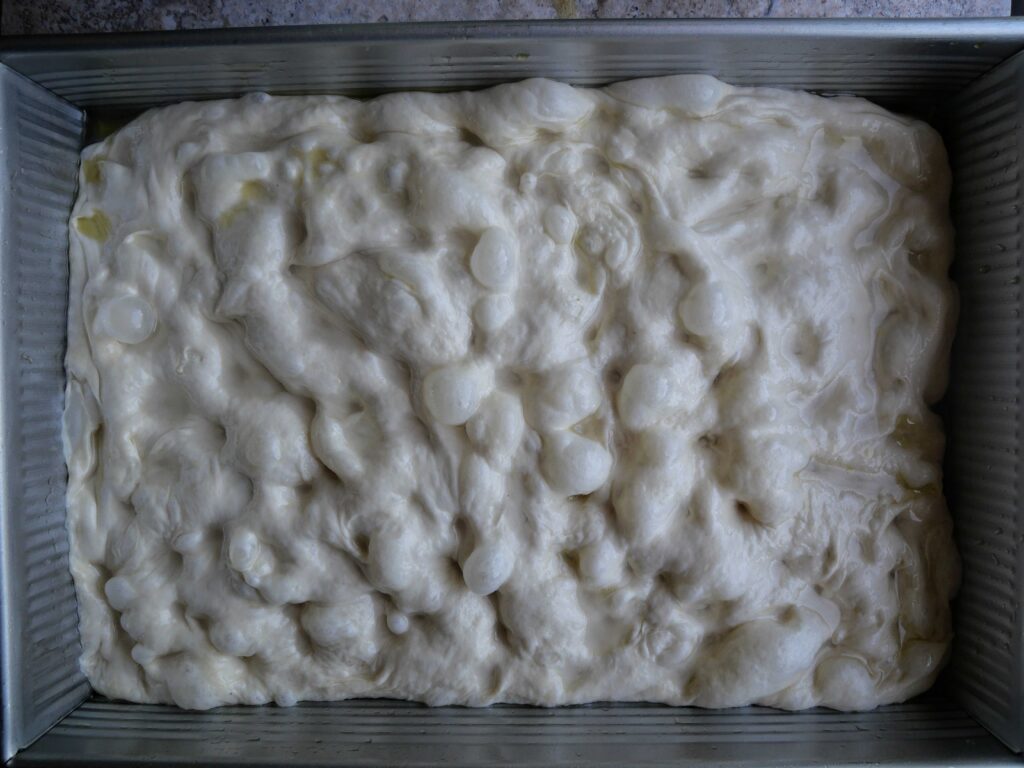
Now you’re going to dimple the dough (with wet fingers so you don’t stick!) all over. Press hard enough to touch the bottom of the pan, but not enough to break the dough. Once you’ve finished dimpling, pour the salt water brine all over the dough, making sure to fill the dimples.
Once done, cover with plastic wrap again and let rest for 45 minutes.
While the dough is resting, set a rack to the bottom of the oven (bonus points if you have a pizza stone to set on top of it!), and preheat the oven to 500 degrees F (we’ll lower this temperature before baking).
You can also make a topping at this time. If you want to follow mine, just combine 1 tbs water, 1 tbs EVOO, 1 teaspoon salt, 1 teaspoon oregano, ½ teaspoon black pepper, a pinch of red pepper flakes and 1-2 springs of rosemary, chopped.
Step 10: Add the topping and bake.
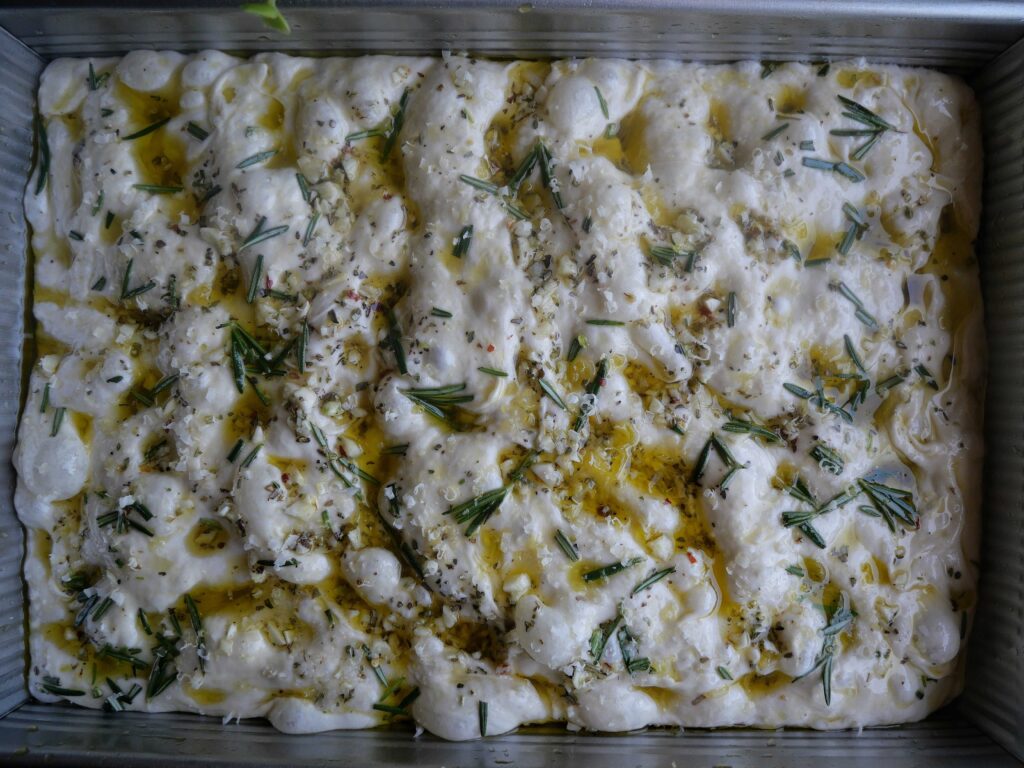
Once the 45 minutes are up, pour the topping all over the dough, making sure to use your hands to spread it out.
I also like to drizzle a little extra EVOO on top, sprinkle a touch more salt, and then give a small grating of Parmigiano-Reggiano.
Once ready, turn the oven down to 425 degrees F and bake for 30 minutes on the center rack. In the last 15 minutes move the tray to bake on the bottom rack, on top of the pizza stone if you have one.
Step 11: Let it rest.
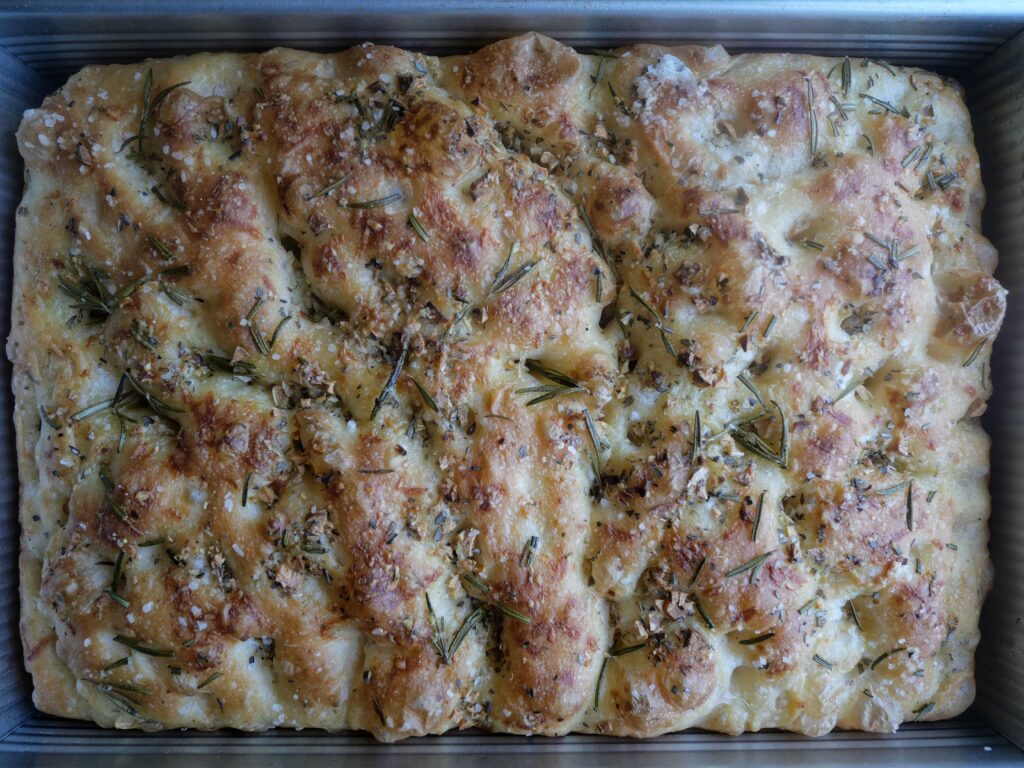
Let the focaccia rest for 7 minutes in the tray, and then transfer to a wire rack to cool completely before cutting.
Overnight Focaccia
Equipment
- 1 9×13 pan
Ingredients
For the dough
- 480 grams King Arthur All-Purpose Flour
- 390 grams warm water
- 14 grams honey
- 14 grams kosher salt
- 2 grams active dry yeast
- 40 grams extra virgin olive oil
For the brine
- 3 tbs warm water
- 1 teaspoon iodized salt
For the topping
- 1 tbs water
- 2 tbs extra virgin olive oil
- 1-2 rosemary sprigs chopped
- 2 garlic cloves finely minced
- 1 teaspoon kosher salt
- 1 teaspoon oregano
- Pinch red pepper flakes
- Parmigiano-Reggiano freshly grated
Instructions
- Add the honey and yeast to the warm water. Mix to combine and let sit for 5 minutes.
- Meanwhile, whisk together the flour and salt. Pour in the water mixture and the olive oil. Use a spatula to stir to combine until all of the dry bits are mixed in. It will create a wet blob. Cover with plastic wrap and a kitchen towel for 5 minutes.
- When the 5 minutes are up, uncover, wet your hand, and stretch and fold the dough 4-5 times. To do this, pull a section of the dough out and then stretch and fold it over like you're wrapping a gift. Rotate the bowl and repeat 4-5 times. Cover back up with the plastic wrap and towel and let rest for 15 minutes.
- Once the 15 minutes are up, repeat the same stretch and fold process. The dough should be more elastic by this round. Once you've stretched and folded, flip the dough over so that the smooth part is on top. Drizzle some more olive oil on top, using your hand to make sure the entire dough ball is covered in the olive oil. Cover with plastic wrap and the towel and leave in the fridge for 12-18 hours.
- The next day, pour a few tbs of olive oil into the bottom of a 9×13 pan. Remove the dough from the fridge, it should have risen and developed some air bubbles. Pour the dough out onto the baking pan making sure the smooth part is on the top. Cover with plastic wrap and a kitchen towel and let sit in a warm place (like the oven with a light on) for 2-4 hours, or until the dough has expanded to 85-90% fill out the pan. (Check after 1.5-2 hours to make sure it isn't overproofing.)
- Make the brine by combining the warm water and the salt. Mix until the salt is dissolved.
- Uncover the dough. If it hasn't fully filled out the pan, you can stretch the corners a bit. Then, dimple the dough by pressing your fingers into it, making sure to touch firm enough that you're hitting the bottom of the pan, but not enough to rip it. Once dimpled, pour the brine all over the dough. Cover again and let proof one last time for 45 minutes. At this time, preheat the oven to 500 degrees. (You'll lower it for the actual bake. this is just to help ensure the top gets golden.)
- Mix together everything for the topping and set aside.
- Once the 45 minute proof is up, uncover the dough, pour the topping over the bread, and add a touch more olive oil, and a grating of Parmigiano-Reggiano if you'd like.
- Lower the oven to 425 and add the focaccia. Bake for ~30 minutes, or until golden on top and the inside reaches atleast 200 degrees F. In the final 15 minutes, move the focaccia to the bottom rack to ensure the bottom crisps up (extra credit if you keep a pizza stone on the bottom at all times and let it cook on top of that!).
- Remove from the oven and let sit in the tray for 7 minutes, then remove to cool completely on a wire rack.

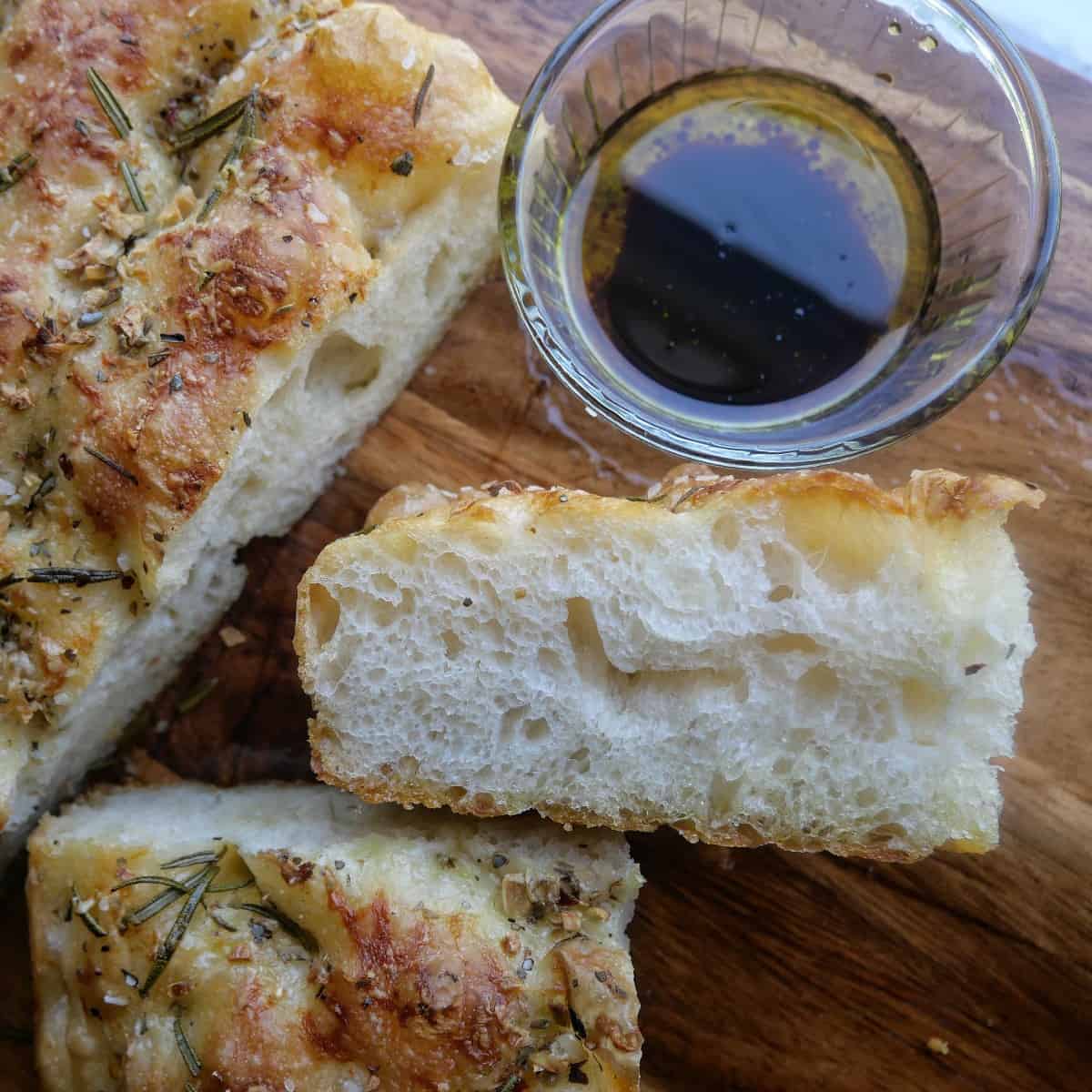

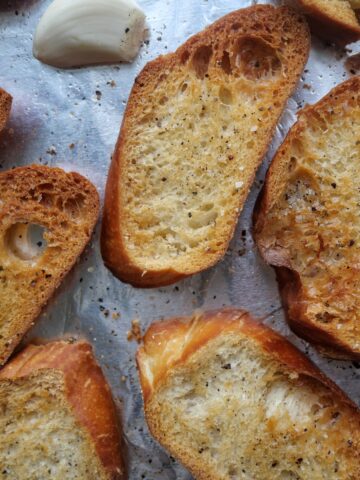
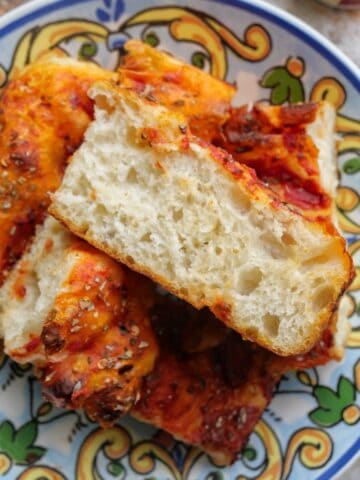


Leave a Reply